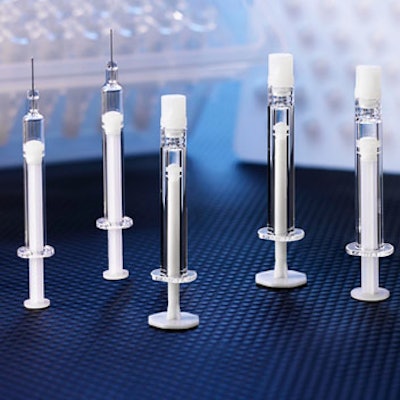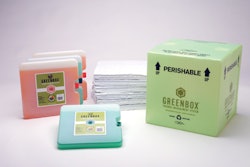The rise in biopharmaceuticals used to treat diseases and chronic conditions such as multiple sclerosis and rheumatoid arthritis has forced drug and packaging manufacturers to seek improved manufacturing processes and more sophisticated container closure and drug delivery systems. Increased compliance requirements and pressure to achieve higher quality have resulted in a variety of new drug delivery options. Prefillable syringes provide convenient, premixed, sterile, fixed dosages.
To answer demands for higher quality, the drug industry has moved toward ready-to-sterilize and ready-to-use components for prefillable syringe systems. These components reduce the levels of extractables and leachables through wash and sterilization processes that reduce the risk of microbiological contamination in the drug product. Components are also available with films that serve as a barrier between the drug and the closure to reduce leachables. Some provide lubricity, so manufacturers can reduce or eliminate the need for silicone oil, which removes a potential source of contamination.
With the development of novel materials, including cyclic olefin polymers such as Daikyo Crystal Zenith® (CZ) resin, manufacturers can now offer high-quality, transparent, break-resistant material that is more inert than glass, is scratch-resistant and, unlike glass, does not flake, which reduces particulate contamination from the container. These resins can also be stored and shipped at low temperature--a requirement of many biologics.
As the industry trends toward the use of prefillable syringe systems, which are often used in devices or delivery systems to aid with the increased need for injection in the home setting, such resins offer a solution. Because of flexibility in molding these polymers, they can be used in a variety of drug delivery systems such as custom cartridges. Plastic prefillable syringe systems help to reduce costly overfill and enhance patient and caregiver safety.
Economic option
Since biologics tend to be expensive, manufacturers are increasingly looking for ways to maximize production efficiency. Prefillables, with their premeasured dosage, can reduce dosing errors and increase patient compliance while saving manufacturers money. Unlike single- or multi-dose vials that may overfill by as much as 30% to account for potential waste, a prefillable syringe can virtually eliminate the need to overfill. This is important where manufacturing and product costs are high and bulk manufacturing capacity is limited.
Additionally, with a vial there is often a great deal of variability when removing product with a conventional disposable needle and syringe. With a prefillable syringe, the nature of its design cuts out that variability and delivers a more accurate dose of the drug to the patient.
Prefillable syringes also provide for greater safety by reducing the potential for inadvertent needle-stick injuries and exposure to contaminated or adulterated products that can occur while drawing medication from vials.
The plastic advantage
Glass prefilled syringes still dominate the market. Switching from a glass prefill to a plastic-molded prefillable syringe can reduce the variability and breakage issues associated with silicone oil and glass use.
Although not yet reaching the adoption level of glass syringes, plastic syringe systems continue to gain strong acceptance from pharmaceutical makers thanks to a variety of benefits. With CZ resin-based syringes, for example, the component manufacturer uses a proprietary fluoropolymer barrier film on syringe components to provide extrusion force without the use of silicone and its concerns about leachables and extractables from elastometric components. The film is molded to the surface of the piston and provides a barrier against organic and inorganic contaminants.
Additional benefits of cyclic olefin polymer syringes include:
• Consistent breakloose and glide force
• Silicone oil-free
• Low exposure to extractables and leachables
• Low particulate levels
• Minimum adsorption and absorption
• Improved drainability
• Excellent low-temperature characteristics
• Break-resistance
• Transparency
• Disposable and environmentally safe
Overcoming variability
Glass is a formed product. To create the component, the glass is heated and mandrels are used to form the syringe’s overall length, nose or tip, and flanges. These actions create dimensional variability. When the syringe is used manually, such variability is overcome by the human user, but with delivery devices such as auto-injectors, the device itself must overcome the variability. Since the device cannot judge the pressure required to do so, failures--including incomplete injections or incorrect needle depth upon injection--may occur. In contrast, a plastic component is molded. This process creates dimensional tolerances that are consistent and tighter than in a glass product.
Eliminating the need for silicone
Silicone is currently used on glass components in prefilled syringes to provide lubricity. During the manufacturing process, the silicone may be applied unevenly, particularly toward the bottom of the syringe, which is less susceptible to the siliconization process. Over time, the silicone may become uneven. Such issues can create break-loose force or sustainability variability, particularly at the end stroke of the piston. That results in incorrect depth upon injection or incomplete injection, especially when the syringe is used in a delivery device such as an auto-injector.
A plastic component may use a more uniform method of providing lubricity. For example, a fluoropolymer coating may be applied to the piston to provide lubricity without the addition of silicone oil. This technology eliminates the risk of sensitivity to silicone, which is a problem for many drugs, and minimizes the interaction between the drug and organic and inorganic extractables.
Reducing extractables and leachables
Many biotech drugs are sensitive to both silicone and tungsten. In the glass prefilled syringe-manufacturing process, a tungsten pin is used to create a hole for the needle. Residual tungsten can become embedded in the syringe glass during the high-temperature formation process. Should the tungsten come in contact with the drug, a reaction can occur. Glues and adhesives are also used to hold the needle in place once it has been staked into the syringe, and these may contaminate the drug.
Enhancing drug delivery capabilities
A plastic component can be molded around a needle, eliminating the need for tungsten pins, glues, and adhesives. This in turn makes the drug safer for the end user and offers manufacturers greater reliability for their product. It also allows for the prefillable syringe to be used in a variety of delivery devices, which enables manufacturers to distinguish their product in a crowded market.
Ultra high-quality plastic syringe systems provide dosage precision and support for new classes of biopharmaceutical products. At the same time, plastic prefillable syringe solutions reduce overfill and breakage, and eliminate extractables and leachables--including silicone. Plastic prefillable syringes present benefits that are gaining increased attention from manufacturers seeking new answers to drug delivery and administration challenges.
The author of this article, Tibor Hlobik, has worked within pharmaceutical packaging for more than 20 years in research and development, quality, technical and marketing roles, primarily at West. He has extensive experience and overall expertise with vial/closure and prefillable syringe packaging systems. He is responsible for supporting business development efforts, and for defining new products and executing strategies for West’s Prefillable Syringe technology platform.
























